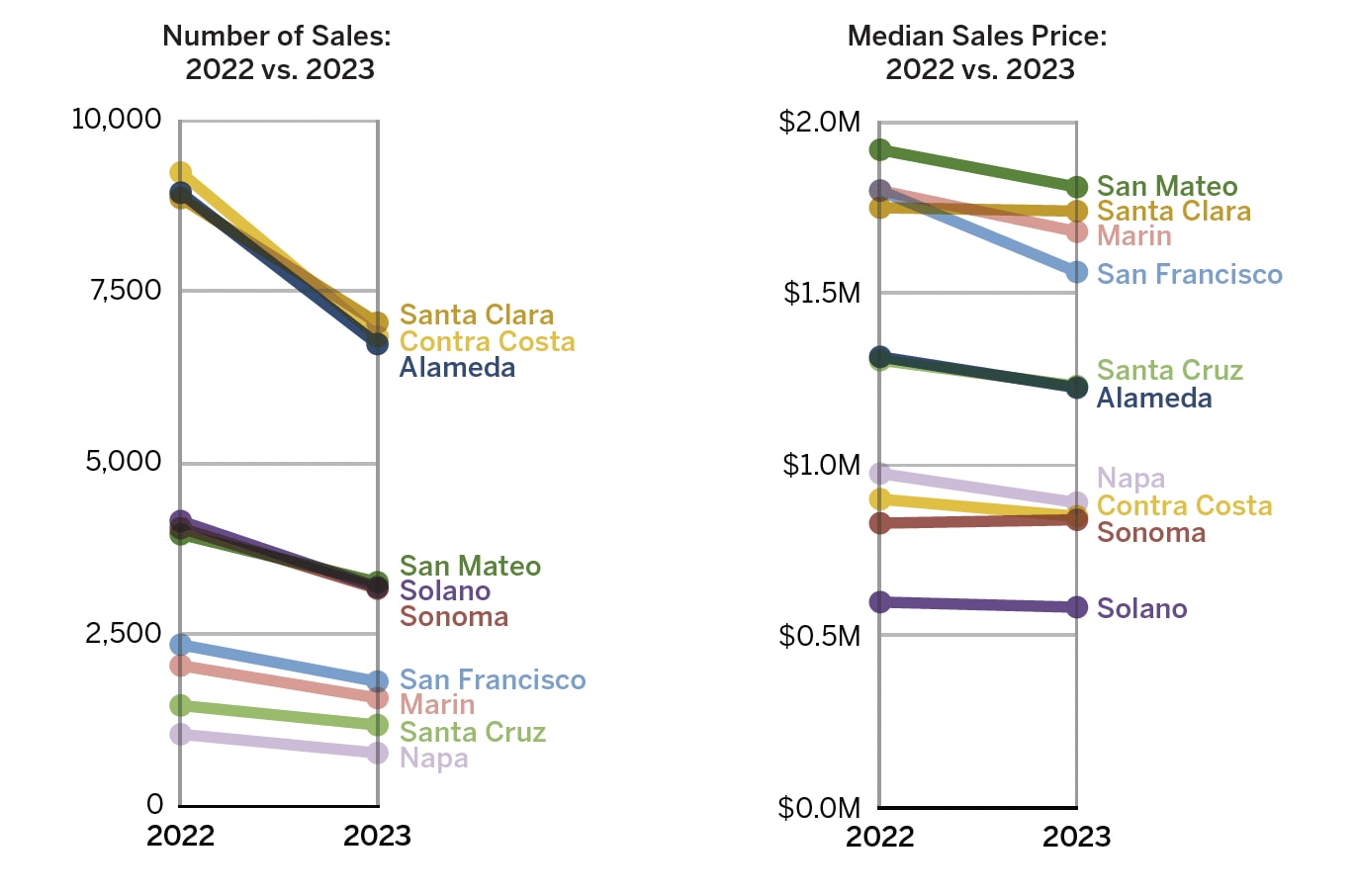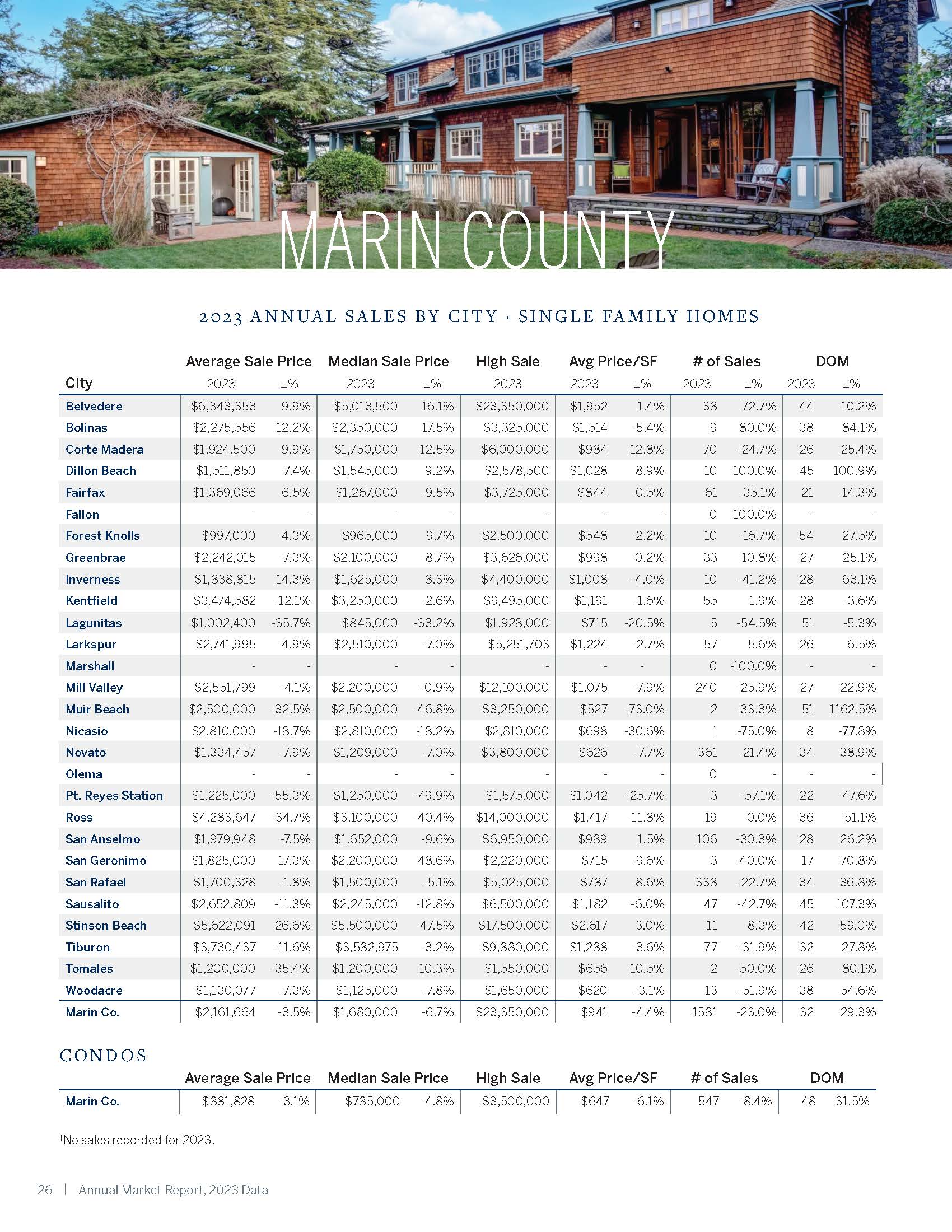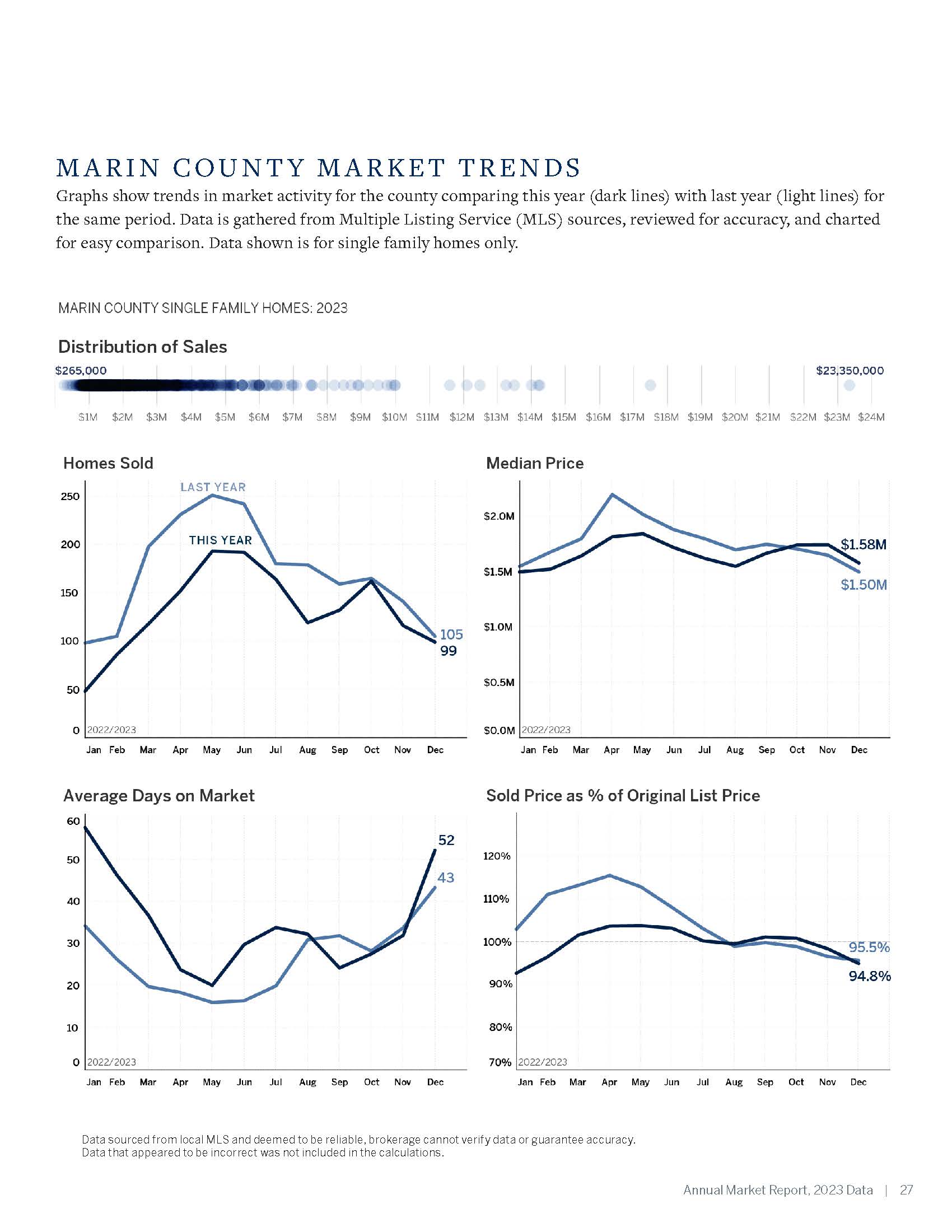Welcome to our Annual Market Report for 2023. As we close the books on another unprecedented year, we provide an in-depth look at the San Francisco Bay Area residential real estate market and how it responded to everything that took place in 2023. In the pages ahead, you will find that sales prices remained the same or decreased slightly compared to 2022 levels, and a limited supply of inventory constricted the number of sales. We begin with an introduction to our brokerage and the power of our brand, highlighting significant milestones at Golden Gate Sotheby’s International Realty in this past year, including over $4 billion in total sales volume in 2023. Diving into the data, our comprehensive market report features economic and real estate commentary presented by our partners at the Rosen Consulting Group (RCG). The report focuses primarily on detached single family homes, with added coverage of the luxury home market, and the significant condominium market in San Francisco. You will also find a selection of our brokerage’s significant sales in 2023 across the SF Bay Area. All data is sourced from the local Multiple Listing Service (MLS) organizations and is thoroughly cleaned by our data experts.
THE SF BAY AREA HOUSING MARKET
LOW INVENTORY IN A STABILIZING MARKET
The housing market stabilized somewhat during the second half of 2023, following the softening that began in mid-2022. For-sale inventory remained low throughout the year, constraining purchase activity for entry-level and trade-up buyers alike. Buyer demand for homes rose within the inner SF Bay Area as many employers pushed workers to return to office locations and commute times increased.
JOB GAINS MODERATE WHILE INTERNATIONAL MIGRATION RISES
Tight labor market conditions, rising wages and slowing in the technology sector all led to a moderation of job gains in the SF Bay Area. The regional economy added an estimated 50,000 jobs last year, while the unemployment rate ticked higher to 3.9%, which was still low by historical standards.
While hiring slowed across a range of industries, SF Bay Area consumer spending and income growth were resilient in 2023. Additionally, renewed international migration brought new households to the region and strengthened housing demand. In fact, in an initial positive sign for the SF Bay Area, international migration into California increased by more than 19% in 2023, building upon the pent-up inflow that nearly doubled migration in 2022.
MORTGAGE RATES CONTINUE TO IMPACT INVENTORY
Despite a modest improvement in mortgage rates during the second half of 2023, many homeowners are still locked into mortgages with rates much below the current level. As a result, the number of active listings remained low throughout 2023, and for-sale inventory decreased further into the end of the year as seasonal trends took hold. In fact, the number of active listings decreased to less than 2,900 as of December 2023, the lowest level since January 2022. Highlighting the low level of inventory, active listings averaged 4,400 homes in 2023, a decrease of 16% from 2022.
Inventory was tight in all counties, as purchases outpaced new listings in half of SF Bay Area counties in December, while the number of listings was nearly unchanged in two more. The largest decreases in average inventory during 2023 were in Alameda and Contra Costa counties, with Santa Clara County not far behind. In Napa and Sonoma counties, inventory increased slightly from an already very low level.
SALES CONSTRAINED BY LOW SUPPLY AND LOWER TECH-SECTOR DEMAND
The number of homes sold in 2023 declined by 23% to less than 36,000. The dwindling supply of homes for sale, as well as elevated mortgage rates and reduced affordability, constrained home sales. The buyer pool in some neighborhoods was further diminished by weakness in the technology sector. Tech sector jobs can provide significant income growth for employees, leading to greater housing demand. In the case of 2023, with many tech firms trimming staff or undergoing hiring freezes, diminished income prospects led to some households remaining on the sidelines.
While the number of sales declined in all SF Bay Area counties, the pullback in sales activity was most significant in counties where options were already limited, including Alameda, Contra Costa and Napa counties. Meanwhile, sales volume was somewhat more stable in San Mateo and Santa Cruz counties.
However, in the fourth quarter of 2023, sales volume was only 7% less than the same period one year prior, compared with a delta of 28% in mid- 2023, ending the year only slightly worse than 2022.
SALES DECREASE MORE FOR THE MID-RANGE PRICE TIERS
Sales activity varied throughout the range of home values. In the SF Bay Area, the decline in sales activity was smaller comparatively at each end of the pricing spectrum. Though fewer homes priced less than $1.25 million and greater than $5 million sold in 2023, the decrease was less than sales between $1.25 and $5 million. In other words, the bulk of the decline in sales occurred within the $1.25 million to less than $5 million range. More specifically, sales slowed the most in the $2.5 to under $5 million price range.
MOST HOMES SELL OVER LIST PRICE
In 2023, 54% of homes closed above the list price, a decrease of six percentage points from 2022. However, this understated the rebound in competition in the second half of 2023. During the last six months of the year, 56% of homes sold for more than the asking price, compared with 50% during the first half of 2023 and 44% during the second half of 2022. Tight inventory focused potential buyers into a more limited subset of homes, particularly in prime neighborhoods. As a result, competition increased in many neighborhoods and fewer homes sold for less than the asking price. Notably, sellers that accepted offers over asking received a little more than 8% over the list price, on average.
PRICES ARE LOWER, BUT END THE YEAR ON A POSITIVE NOTE
The median sales price in the SF Bay Area decreased by 3.8%, to $1.25 million in 2023, with prices also declining in nearly all counties. The median sales price in Santa Cruz County was stable, while the price increased slightly in Sonoma County in 2023. However, examining just the last quarter of 2023 indicates a different trend. The median sales price increased by 6.8%, year-over-year, in the fourth quarter in the SF Bay Area. This price appreciation was broad-based, with eight of the ten SF Bay Area counties registering a year-over-year price increase during the last quarter of the year.
In Alameda and Santa Clara counties, a resurgence in competition drove stronger price growth, as of the fourth quarter of 2023. But some regions still gave up ground during the fourth quarter, including Santa Cruz, San Francisco and Napa counties. In fact, in Santa Cruz County, the
year-end median sales price fell by a little more than 7% during this period, as the sale of homes priced above $1.25 million declined, while the sales of homes priced below $1.25 million held up relatively well.
PACE OF SALES COMPARES FAVORABLY IN SECOND HALF OF THE YEAR
More broadly, average days on market remained elevated in the SF Bay Area during 2023, despite a slight downtick in the latter half of the year. The average number of days spent on the market was 28 days among homes sold during 2023, five days longer than 2022. However, the number of days on market began to trend down towards year-end. In markets where second homes and vacation homes accounted for a larger proportion of listings, such as Napa, Santa Cruz and Sonoma counties, the average days on market increased more significantly in 2023, and did not improve much in the second half of 2023. Strong demand met limited inventory in Santa Clara and Alameda counties, where increased competition led to some buyers offering shorter close periods. This competition helped keep average time on market in these counties relatively stable in 2023.
LOOKING AHEAD
While the broader SF Bay Area housing market remains somewhat constrained by limited inventory to start 2024, demand for homes remains strong. Mortgage rates have fallen in recent weeks, which may bring some sidelined buyers back to the market. Additionally, the recent drop in rates may even make refinancing an option for those that purchased last year. Overall, economic conditions in the region should remain on par with 2023, with modest job and income gains across a range of industries. The key tech industry may have stabilized, which should help housing demand in many neighborhoods. For-sale inventory may remain somewhat limited for the foreseeable future. This will continue to constrain sales volume but at the same time potentially lead to increased competition in prime neighborhoods and gains across a range of price points.
CLICK HERE TO READ THE FULL SF BAY AREA MARKET REPORT



